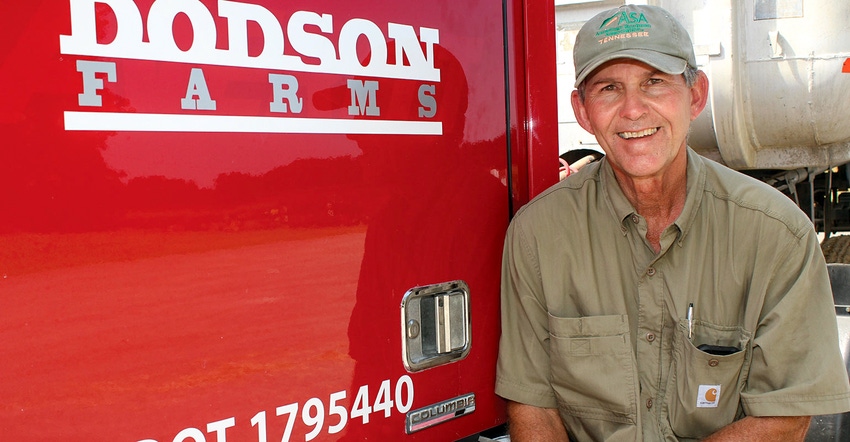May 1, 2020

It’s a bright, spring morning, and Johnny Dodson would like to be planting corn on his farm near Halls along the western edge of Tennessee. He can’t because his fields are too wet following another weekend of rain.
At a time when COVID-19 is wreaking havoc with much of the world’s economy, farmers like Dodson are dealing with another problem — weather that has kept many of them out of their fields for the second spring in a row.
“Dyer and Obion counties missed one of these last rains, and they’ve been able to plant some corn,” said Dodson, referring to the counties north of Lauderdale County where he farms. “They’ve planted a few acres in Crockett County (to the east), but we haven’t started.”
Dodson, who has seen his share of weather difficulties in three decades of farming, has learned patience in his response to the challenges of farming along the Mississippi River and other rivers in the area.
Last year, he was unable to plant 200 acres of corn in the Mississippi River bottom lands he farms after it rose to near record levels during the spring. Another 200 acres of river bottom land on a couple of other farms couldn’t be planted.
Normally, the rivers recede enough for growers to plant in time to harvest a decent yield. That didn’t happen in 2019.
Field never dried
“We tried to plant cotton or soybeans after it got too late to plant corn on that land,” he said. “But the fields never dried out enough to plant. We wanted to do some land-levelling in those fields in August, but then it started raining again.
“By then, we were beginning to harvest, and it was all hands on deck,” he said. “We never put a land plane in those fields. Later, I wanted to prepare a site for a new grain bin, and we couldn’t do that, either.”
Dodson believes the high rainfall events that have led to flooding on the Mississippi and the other rivers that flow through west Tennessee have been becoming more frequent and more intense in the last 10 years.
“One of these days, we’re going to wake up and it will be 80 degrees, and it will be time to plant cotton,” he said. “We’ll take the corn plates out of the planters and replace them with cotton plates.”
COVID-19 has not spared the rural counties in west Tennessee, although they haven’t been hit as hard as the state’s metropolitan areas. Lauderdale County had reported 15 confirmed cases of the Coronavirus by April 19 while Tennessee reported slightly more than 7,000 cases and 148 deaths by that date.
“We had finished most of our shop work before the governor issued a stay-at-home order,” said Dodson, who has three fulltime employees and hires part-time workers when needed. “Our governor was a little later issuing the order than some of the other states.
Supplies
“We haven’t had to go into many places to pick things up,” he said. “Where you have charge accounts, and most places do around here, they just show you the receipt and say they’ll add it to your bill. The John Deere place and the local co-op bring the part out and put it in your truck after you order it on the phone.”
He serves on the board of directors of one of the local banks. They had their meeting the next day after Dodson was interviewed by teleconference.
Dodson says he will continue to look for a window of opportunity to plant corn until around May 1. “I have a little bit of irrigation, but not enough to cover all my corn acres. If I can’t plant corn by the first week in May, the risk is too great.”
The Mississippi River has been falling but has seen a slight rise in the four days before the interview. Farmers all over the Mid-South are hoping the pattern of a 1- or 2-inch rain every three or four days will begin to ease.
“We had several years of drought in the 1990s and the 2000s,” he said. “We’d rather not have that happen again, but we do need more dry weather. Of course, the flooding that occurs is the reason the land is as productive as it is.”
On the other side of the planting equation, there are few positives for planting corn or cotton. “West Texas crude oil is trading at $11 a barrel this morning,” he noted. “At those prices the demand for ethanol is almost zero.” (Later that day, oil prices dropped to a negative value for the first time in history.)
COVID-19 outbreaks
COVID-19 outbreaks in a handful of meat packing plants in the Midwest have caused disruptions to the processing side that could eventually lead to more reductions in feed prices.
“The tariffs have also caused some long-term demand destruction,” said Dodson, who served as president of the American Soybean Association in 2008 and 2009. “We were forecast to have a huge corn carryover coming into last year. Mother Nature took over and reduced the size of the crop, but we may be facing a similar situation again.”
From an economic standpoint, farmers might be better off switching from corn or cotton to soybeans because of the comparative costs for producing them. “Soybeans cost less to grow, although none of the prices for those commodities are that attractive now,” he said.
“But I prefer to have a diverse crop mix. I don’t like to put all my eggs in one basket, so I’ll wait a little longer.”
About the Author(s)
You May Also Like






